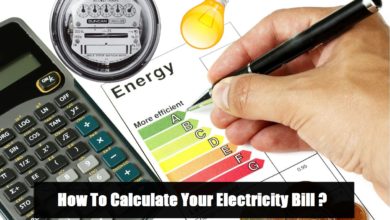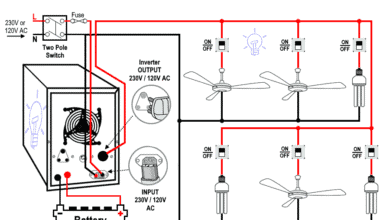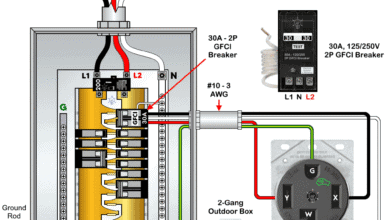Efficiency of Transformer – All Day Efficiency & Maximum Efficiency
Transformer’s Efficiency: All Day Efficiency & Condition for Maximum Efficiency
Efficiency of Transformer
Similar to other electrical machines, (e.g. motors, alternator/generators etc.) the transformer’s efficiency on specific load and power factor can be determined by dividing its input on output while the value and rating of both quantiles should be the same i.e. in Watts or kilowatts. In other words, the efficiency of transformer may be defined as the ratio between its output and Input.
Transformer’s Efficiency = Output / Input
Keep in mind that a transformer has very high efficiency because the losses occur in the transformer are very low. Since the Input and output are almost equal, therefore measurement of input and output is practically not possible. The best way to find the transformer’s efficiency is to first determine the losses in transformer and then calculate the transformer’s efficiency using the following formulas.
Related Posts:
Formulas of Transformer’s Efficiency
Efficiency = η = Output / Input
Efficiency = η= Output / (Output + Losses) … (As Input = Output + Losses)
Efficiency = η= Output / (Output + Copper Losses + Iron Losses)
Efficiency = η = (Input – Losses) / Input … (As Output = Input – Losses)
Efficiency = η = 1 – (Losses / Input)
As we know that the rating of transform is expressed in kVA not in kW. But the efficiency doesn’t depend on VA i.e. it would be expressed in power – watts ( or kW) not in kVA. Although, the losses are directly proportional to VA (Volt-Amperes), thus, efficiency depends on power factor on any kind of VA load. Keep in mind the efficiency would be maximum on unity (1) power factor.
- Related Post: Power Transformers Maintenance, Diagnostic & Monitoring
Good to Know
We can also find the transformer’s efficiency by determining:
- Core losses by open circuit test or No Load test, and
- Copper losses by short circuit test.
Condition for Maximum Efficiency of Transformer
We know that,
Copper Loss = WC = I12 x R1 or I22 x R2
Iron Loss= WI = Hysteresis Loss + Eddy Current Loss = WI = WH + WE
Suppose to the primary side of transformer…
Primary Input = P1 = V1 x I1 Cosθ1
Efficiency = η = Output / Input
Efficiency = η = (Input – Losses) / input … (As Output = Input – Losses)
Efficiency = η = (Input – Copper losses – Iron Losses)/Input
Efficiency = η = (P1 – WC – WI) / P1
Efficiency = η = (V1 x I1 Cosθ1 – I12 x R1 – WI) / V1 x I1 Cosθ1
Taking LCM
Efficiency = η = 1- (I12 x R1 / V1I1 Cosθ1) – (WI / V1 x I1 Cosθ1)
Or
Efficiency = η = 1- (I1 x R1 / V1 Cosθ1) – (WI / V1 x I1 Cosθ1)
Differentiating both sides w.r.t I1.
Dη / dI1 = 0 – ( R1 / V1 Cosθ1) + (WI /V1 x I12 Cosθ1)
Dη / dI1= – ( R1 / V1 Cosθ1) + (WI / V1 x I12 Cosθ1)
For maximum efficiency, the value of (Dη / dI1) should be minimum i.e.
Dη / dI1 = 0
Thus, the above equation can be rewritten as:
R1 / (V1 Cosθ1) = (WI /V1 x I12 Cosθ1)
Or
WI = I12 x R1or I22 x R2
Iron Loss = Copper Loss
The value of Output current (I2) on which maximum efficiency can be gained:
I2 = √ (WI / R2)
The value of output current (I2) is the factor which makes it possible to equal the value of copper loss and iron loss (i.e. copper loss = iron loss).
Good to Know
- Efficiency is usually less than 1 and it is often expressed as a percent (%).
- Ideal Transformer is 100% efficient i.e. the efficiency of ideal transformer is 1.
- Practical transformers efficiencies are generally quite high in compression to other electrical machines and electronics devices (i.e. motors, generators etc.) on the order of 90 t0 98%.
All Day Efficiency of Transformer
As we know that the commercial or typical efficiency of a transformer is the ratio of its output and input in watts.
Efficiency = Output (in Watts) / Input (in Watts)
But there are a number of transformers whose performance can’t be monitored according to the general efficiency formula given above.
Those distribution transformers which supply electrical energy to the lighting and other general circuits, their primary energizes for 24 hours, but the secondary windings do not energize all the time at once. In other words, secondary windings only energize at the night time when they supply electrical energy to lighting circuits. I.e. secondary windings supply eclectic power for very small loads or no load for maximum time in 24 hours. It means that core loss occurs for 24 hours a day regularly (during the operation) but copper loss occurs only when the transformer is on load.
Therefore, the designers realize the necessity to design a transformer with as low core losses as possible. As copper loss depends on load, therefore, they should be neglected. In these types of transformers, we can only track their performance by determining the all day efficiency.
All day efficiency is also known as “Operational Efficiency”. On the basis of usable energy, we estimate the all day efficiency for a specific time (during the 24 hours = one day) and it can be calculated using the following formula.
All Day Efficiency = Output (in kWh) / Input (in kWh)
To know the exact value of all day efficiency, we must know about the load cycle i.e. how much load is connected to the transformer and for how much time (in 24 hours).
Related Posts:
- Transformer Losses – Different Types of Losses in a Transformer
- Losses in a DC Motor – Power Stages & Efficiency of DC Motor
- Losses in a DC Generator – Power Stages & Efficiency of DC Generator
- Losses in a induction Motor – Power Stages in Induction Motors
- Losses in Alternator – Power Stages & Efficiency of Synchronous Generator
- Losses in Synchronous Motor – Power Stages & Efficiency of Synchronous Motors
- Losses in Electrical Machines – Formulas and Equations
- What is Motor Efficiency and How to improve it?
- Uses and Application of Transformer
- Advantages of Three Phase Transformer over Single Phase Transformer








If we connect the transformer in the circuit.
Then circuit follow the ohm’s law or not??????
Good matter